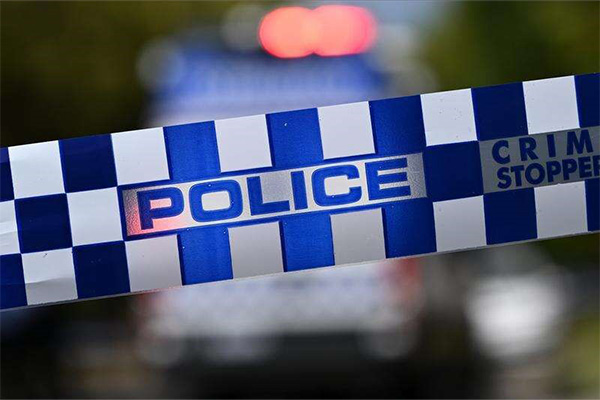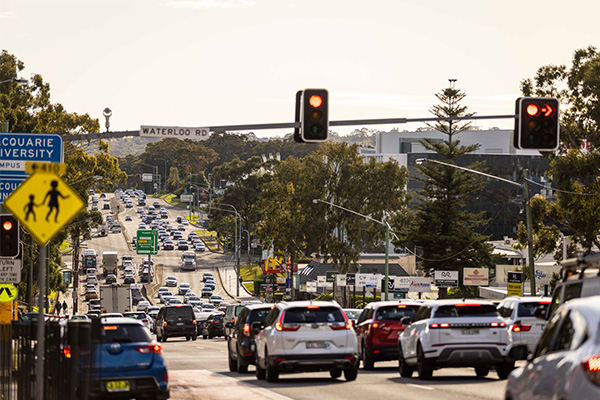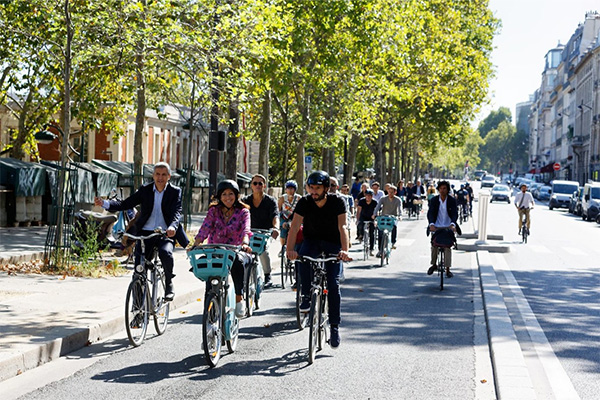Road trauma statistics have trended in the wrong direction over the last few years. 370 lives were lost in the last year in NSW, 100 more than in the previous 12 months. This is a 37% increase. 62 people died in crashes in January and February 2024, up 29% on the 3-year average for the same time of year. For every death there are 5 serious, life changing injuries. Each crash impacts many other people as well. Friends, family members, first responders and bystanders are left reeling.
The NSW Government Towards Zero campaign is not on course to meet its targets - a 50% reduction in fatalities by 2030, and zero fatalities by 2050.
Police tape across NSW roads is an all-to-common sight. There were 3277 crashes that caused serious injury or death in the year to June 2023. That is just under 10 per day. (Image: AAP Newswire)
A gathering of experts in Sydney
Bicycle NSW welcomed the NSW Road Safety Forum in February. Arranged in response to the spiralling statistics, international experts and Australian policy makers shared ideas to turn the trajectory around.
Bicycle NSW CEO Peter McLean attended the forum. “On the whole, it was a productive day,” says Peter. “We heard about initiatives that have been proven to work in other jurisdictions. Everyone agreed that lowering speed limits is the critical first step – given that it will take decades to upgrade the most dangerous roads.”
“But Bicycle NSW is frustrated that an essential strategy for making roads safer is continually overlooked: reducing the need to drive by prioritising active and public transport.”
An audience lacking diversity failed to reflect the full range of people affected by road trauma. Where are the elderly, children, indigenous people, migrant workers? (Image: Transport for NSW)
Steps in the right direction
“It was very pleasing that NSW Government ministers and senior Transport for NSW staff were in attendance all day at the forum,” said Peter McLean. “I felt this demonstrated a commitment to change.”
However, there was no local government representation – a significant omission considering that councils manage 75% of the road network. And, predictably, the speakers and panelists were mostly white, professional, middle aged and male. Our most vulnerable road users – the young, the elderly, the disabled, indigenous people, bike riders, motorcyclists, pedestrians and migrant communities – did not have a clear voice at the forum.
There was strong focus on two major risk factors for road crashes: Dangerous speeds and dangerous roads.
The keynote speaker was Swedish expert Johan Strandroth. Dr Standroth is a former crash scene investigator who steered Sweden’s Vision Zero policy, which saw the death toll halve in 10 years. He aligned with experts from Monash University on the urgent need to reduce speed limits.
There is no argument that slowing vehicles will saves lives. Research from around the world shows that a 1% reduction in speed leads to a 4% reduction in fatalities. Need more evidence? Read this great mythbusting article from New Zealand.
Bicycle NSW has long urged the NSW Government to set lower and more appropriate speed limits on all types of roads. Other walking and cycling advocacy groups are beating the same drum.
It is harder to fix dangerous roads. Over the last 100 years, Australian roads were designed to meet the wrong criteria. Efficient, free-flowing traffic was prioritised above all else. Turning this juggernaut around requires funding, skills and capacity – all lacking in the local road construction sector.
The multilane ‘stroads’ which bisect Australian suburbs are dangerous by design. Multiple lanes, complex intersections, variable speed limits, confusing signage, slip roads, unprotected pedestrian crossings and regular driveway entrances create hazards. (Image: Macquarie Park Innovation District)
As with planting trees, the best time to start doing things differently was 30 years ago. The second-best time is NOW. But even if NSW Government pulls out all the stops today, experts reckon it will take 200 years to make the state’s road network safe.
Whereas lowering the default speed limits can happen at the stroke of a pen – well almost! The Swedish model is recommended. On undivided regional and rural roads, the speed limit is 80km/h. Main roads and arterials in urban area are 50km/h. And local roads, residential streets and town centres have a 30km/h default speed limit.
Of course, Bicycle NSW has collaborated for several years with WalkSydney, 30Please and Better Streets to call for 30km/h speed limits to be rolled out in areas of high pedestrian activity, on mixed traffic cycle routes and around schools.
In Sweden, the local council has the authority to reduce (not increase) the speed limit. So the national government just sets the default and councils can then make 40 zones into 30 zones and so on. This isn't the case in NSW or anywhere in Australia but it is policy that could change.
We are hopeful that the needle is moving slowing towards a safer future as politicians align to reduce road trauma.
Formal commitments will follow
“No concrete promise to lower limits was made on the day,” says Peter. “An outcomes report is due shortly. Bicycle NSW will expect to see reduced default speed limits as the key theme, with a clear timeline for implementation. We will report back to our Members on the contents of the report. And, of course, we will elevate our advocacy to the NSW Government if commitments are lacklustre.”
“Interestingly, there was no real consensus on why serious crashes are increasing,” said Peter. “Some panel members felt that drivers have become more belligerent. The Transport Secretary mooted that the growing mistrust of government plays out in not adhering to road rules.”
The danger posed by large SUVs and utes dominating the vehicle fleet was not discussed. “Although I did have a private conversation with a senior police officer regarding dangerous vehicles,” said Peter. “The NSW Police are extremely concerned by the rise in unregulated modifications to cars and utes. Steering, braking and suspension are all compromised. Compliance regimes are urgently needed.”
That missing ingredient
Active and public transport must be an essential part of any strategy to reduce the road toll.
There is a strong correlation between distance driven and crashes. One of the best ways to reduce risk of road trauma is to reduce the amount of time people spend in cars.
And yet road safety initiatives continue to be firmly car-centre. Even in Sweden. They focus on roads, cars and drivers - not mode shift.
Bicycle NSW and WalkSydney made several recommendations for the NSW Road Safety Forum. Read our joint statement here
Of course, reducing speed limits was central to our advocacy. But we also stressed how important it is to:
- Provide viable alternatives to driving
The NSW Government must step up efforts to deliver a full range of equitable alternatives to driving in all parts of metropolitan and regional NSW.
Quality walking and cycling infrastructure, well shaded by trees, must be a priority for all levels of government, alongside urban planning policy that delivers mixed used, compact developments to reduce the need to travel. Research suggests there are over 2 million car trips per day which are under 2km long in Greater Sydney. Switching some of these trips to active modes is low-hanging fruit for improved road safety.
Public transport between towns must be viable in regional areas. It is relatively affordable to increase services, reduce ticket prices and facilitate trip planning to encourage people to use buses and trains. Bikes must be allowed unboxed on buses and trains so passengers can address last mile barriers.
To help focus the minds of all stakeholders, NSW Government transport strategies should include targets for mode shift and kilometres travelled, as is now the case in countries such as New Zealand and Scotland.
Mayor Anne Hidalgo biking in Paris. The French government will spend €2 billion to expand cycling infrastructure across the country as part of a broader effort to encourage people to ditch their cars. This is how you get to Vision Zero, and create safe, beautiful places. The return on investment is massive. (Image: Cyclist)
- Deliver more enforcement and education for drivers
Education campaigns around sharing the road must be well-resourced to reach all corners of the community. For example, Minimum Passing Distance legislation has been in place since 2018 but public awareness is limited. The most recent Transport for NSW Share the Road video disappeared into the ether.
The focus of enforcement and messaging must shift from victims to drivers e.g. "Walk Safety to School Day" sends the wrong message about who should modify their behaviour. This driver-centric mindset has led to ‘solutions’ such as pedestrian fencing and overbridges to keep pedestrians from being harmed by vehicles. But these are 100% car infrastructure. They create enormous barriers to active transport.
And it is essential to align enforcement to risk, with evidence-based criteria informing enforcement programs and the setting of appropriate fines
- Increase funding for active transport
NSW currently only spends 0.2% of its transport budget on active travel. This is 100 times below that recommended by the UN (20%).
We ask the NSW Government to significantly increase walking and cycling infrastructure and programs because it is a safer form of transport, it's great for the environment and community health.
Of course, active transport infrastructure averages 4:1 to 5:1 return on investment (Queensland Government and TfNSW) due to the enormous benefits to community health, productivity, and environment.
Help us keep up the pressure for safer roads and Better Streets!
We’d love you to join Bicycle NSW and support our advocacy to make NSW better for bike riding. You will also ride easy, covered by our comprehensive insurance and enjoy many other Member-only benefits.





